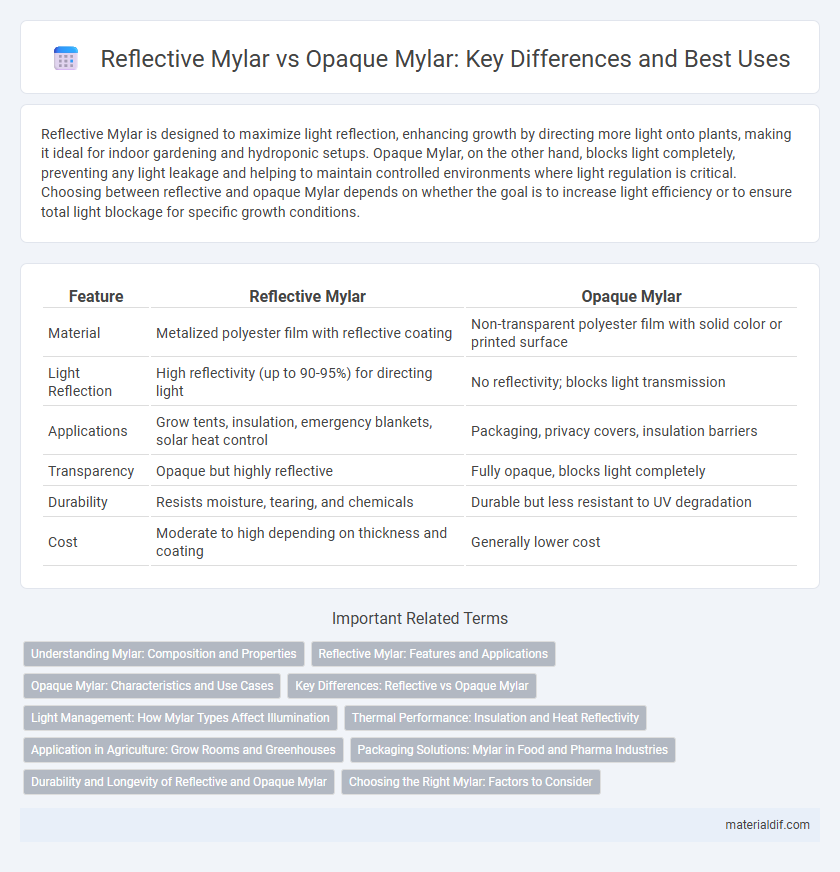Reflective Mylar is designed to maximize light reflection, enhancing growth by directing more light onto plants, making it ideal for indoor gardening and hydroponic setups. Opaque Mylar, on the other hand, blocks light completely, preventing any light leakage and helping to maintain controlled environments where light regulation is critical. Choosing between reflective and opaque Mylar depends on whether the goal is to increase light efficiency or to ensure total light blockage for specific growth conditions.
Table of Comparison
| Feature | Reflective Mylar | Opaque Mylar |
|---|---|---|
| Material | Metalized polyester film with reflective coating | Non-transparent polyester film with solid color or printed surface |
| Light Reflection | High reflectivity (up to 90-95%) for directing light | No reflectivity; blocks light transmission |
| Applications | Grow tents, insulation, emergency blankets, solar heat control | Packaging, privacy covers, insulation barriers |
| Transparency | Opaque but highly reflective | Fully opaque, blocks light completely |
| Durability | Resists moisture, tearing, and chemicals | Durable but less resistant to UV degradation |
| Cost | Moderate to high depending on thickness and coating | Generally lower cost |
Understanding Mylar: Composition and Properties
Reflective Mylar consists of a metallized polyester film that provides high reflectivity and excellent light diffusion, making it ideal for applications requiring heat insulation and light reflection. Opaque Mylar, by contrast, features a non-transparent polyester base that blocks light transmission completely, offering superior privacy and protection against light exposure. Both types exhibit strong tensile strength, chemical resistance, and durability, but their differing optical properties dictate their specific use cases in industries like insulation, packaging, and horticulture.
Reflective Mylar: Features and Applications
Reflective Mylar features a highly reflective surface that efficiently redirects light, making it ideal for applications requiring enhanced illumination such as grow rooms, photography, and insulation. This material offers superior durability, moisture resistance, and temperature stability compared to Opaque Mylar, which lacks reflective properties and is mainly used for privacy or decorative purposes. Its ability to maximize light output while conserving energy positions Reflective Mylar as a preferred choice in horticulture, emergency blankets, and thermal insulation products.
Opaque Mylar: Characteristics and Use Cases
Opaque Mylar is characterized by its non-transparent, solid construction that prevents light transmission, making it ideal for applications requiring light blockage or privacy. It offers excellent durability, moisture resistance, and insulation properties, commonly used in packaging, light-blocking curtains, and protective covers. Its ability to reflect heat and block UV rays makes opaque Mylar a preferred choice in thermal blankets, emergency shelters, and energy-efficient window films.
Key Differences: Reflective vs Opaque Mylar
Reflective Mylar is designed with a metallic surface that enhances light reflection, making it ideal for increasing brightness and energy efficiency in grow rooms or insulation applications. Opaque Mylar, on the other hand, features a non-transparent, matte finish that blocks light completely, providing privacy and preventing light penetration. The key difference lies in Reflective Mylar's ability to maximize light distribution, while Opaque Mylar focuses on light blockage and concealment.
Light Management: How Mylar Types Affect Illumination
Reflective Mylar features a highly polished surface that maximizes light reflection, increasing illumination efficiency by up to 95%, making it ideal for grow rooms and photography studios. Opaque Mylar, in contrast, blocks light transmission entirely, preventing any light leakage and ensuring complete light control in sensitive environments. Selecting the appropriate Mylar type directly influences light management strategies by balancing reflection intensity and light containment based on specific application needs.
Thermal Performance: Insulation and Heat Reflectivity
Reflective Mylar excels in thermal performance by significantly reducing heat transfer through its high reflectivity, which can reflect up to 97% of radiant heat, making it ideal for insulation applications in both hot and cold environments. Opaque Mylar, while providing a strong barrier against light and moisture, offers lower reflectivity and typically relies more on its thickness and density for insulation, resulting in less effective thermal resistance compared to reflective variants. The choice between reflective and opaque Mylar should consider the specific insulation needs, with reflective Mylar being superior for reducing radiant heat gain and opaque Mylar better suited for blocking light and providing structural durability.
Application in Agriculture: Grow Rooms and Greenhouses
Reflective Mylar enhances light distribution in grow rooms and greenhouses by maximizing light reflection and improving photosynthesis efficiency, leading to increased plant growth and yield. Opaque Mylar is used to block light entirely, creating controlled environments for specific plant stages like germination or dark cycles. Choosing between reflective and opaque Mylar depends on the need for either enhanced light reflection or complete light blockage in agricultural applications.
Packaging Solutions: Mylar in Food and Pharma Industries
Reflective Mylar enhances packaging solutions in the food and pharmaceutical industries by offering superior light and moisture barrier properties, preserving product freshness and potency. Opaque Mylar provides additional protection against UV light exposure, which is critical for sensitive pharmaceuticals and light-sensitive food products. Both types ensure durability and extend shelf life, meeting stringent industry standards for safe and effective packaging.
Durability and Longevity of Reflective and Opaque Mylar
Reflective Mylar is highly durable due to its metallic coating, which enhances resistance to wear, moisture, and UV exposure, ensuring longer lifespan in various environments. Opaque Mylar, while still robust, typically lacks the same level of UV protection and reflective properties, making it more prone to degradation over time when exposed to harsh conditions. Overall, Reflective Mylar offers superior longevity and sustained performance compared to Opaque Mylar, especially in outdoor or high-exposure applications.
Choosing the Right Mylar: Factors to Consider
Reflective Mylar offers superior light diffusion and heat retention, making it ideal for indoor gardening and insulation applications, while Opaque Mylar provides enhanced privacy and light blocking capabilities suited for packaging and artwork protection. When choosing the right Mylar, consider factors such as light reflectivity needs, durability, and specific use-case environments to optimize performance. Thickness, reflectivity percentage, and environmental resistance are critical data points influencing the suitability of Mylar types for precise applications.
Reflective Mylar vs Opaque Mylar Infographic

 materialdif.com
materialdif.com